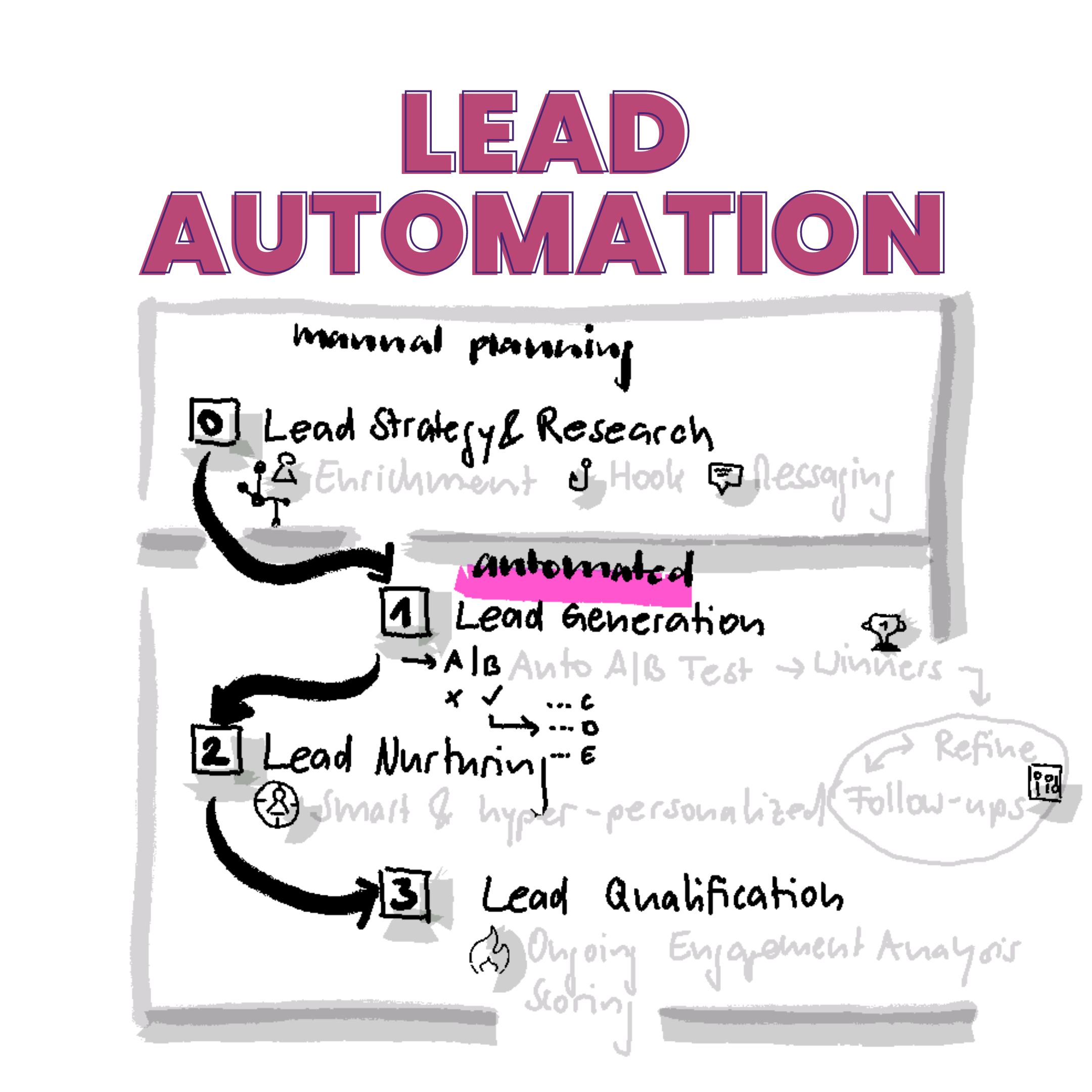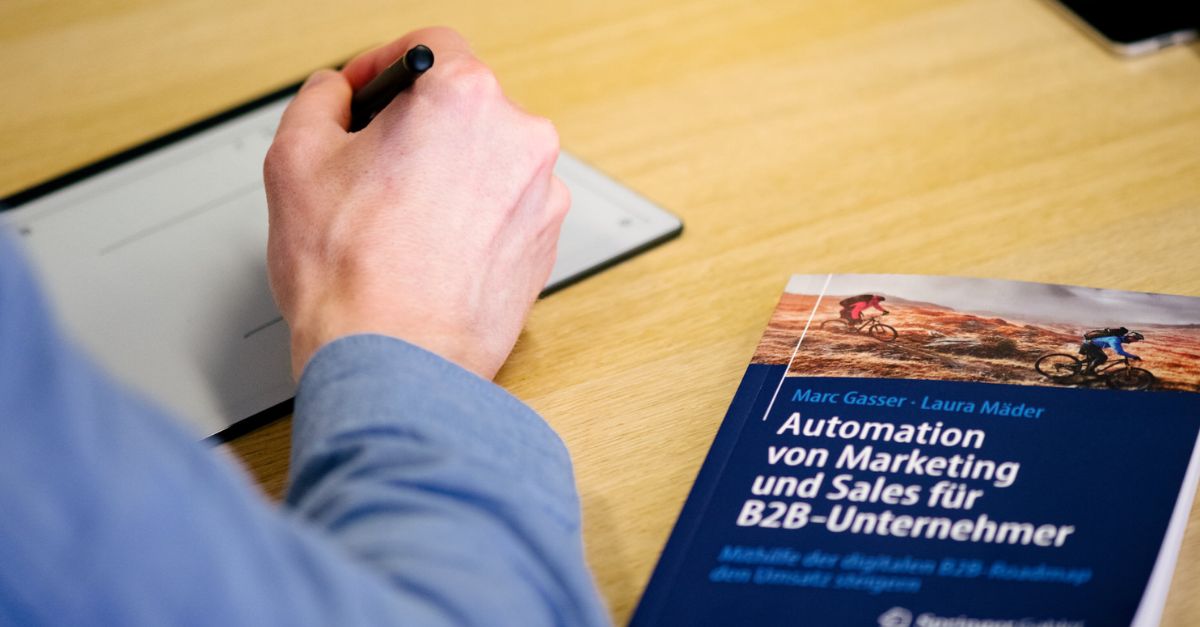Lead Automation: From Cold to Engaged
Many mid-sized B2B companies find themselves at a crossroads, typically following one of two distinct paths: relying on traditional B2B marketing tactics vs. tackling the martech buffet, in other words, using a series of multiple tools or platforms that can help manage marketing campaigns. Both paths come with their set of challenges.
Listen to the podcast:
The first path is rooted in traditional B2B marketing strategies. Faced with limited marketing resources, these companies often turn to tried-and-true methods such as attending conferences, sending out newsletters, and engaging in extensive networking efforts. While these tactics are sales-focused, they come with a growing challenge: traditional B2B marketing alone may no longer be sufficient to meet their objectives.
On the other hand, the second group of companies is eager to embrace the digital age. They eagerly explore the realms of marketing automation and artificial intelligence, seeking to integrate these cutting-edge technologies and processes into their operations.
However, many of them become overwhelmed by the vast array of possibilities and an abundance of available tools. The fear of selecting the wrong tool, only to discover a superior option shortly thereafter, can be paralyzing.
This dilemma often leads to a state of inertia, where some companies hesitate to take any action, waiting indefinitely for the perfect solution to materialize. Meanwhile, those who are more proactive demand rapid results.
Yet, the reality is that implementing new tools, processes, and technologies is a time-consuming endeavor. It invariably takes longer than anticipated, encountering its share of bugs and frustrations, often yielding less-than-optimal results.
So, how can B2B companies effectively boost their revenue, extend their reach, and consistently generate leads to ensure a perpetually full sales pipeline?
Lead Automation for B2B Mid-Sized Companies: What Is It?
Lead automation serves as a scalable marketing-sales system that's constructed once and continues to deliver a steady stream of leads to B2B businesses over time.
Now, you might be wondering, how exactly does one go about building this lead automation machine?
Think of lead automation as a systematic and scalable approach, much like a digital production or assembly line that churns out leads. Picture different modules being configured and assembled at various stations along this production line.

The end result is the lead automation machine, comprising three key components: Lead Generation, Lead Nurturing, and Lead Qualification. Each part of this machine is meticulously configured, tested, and optimized. It's important to note that each machine has to be unique, tailored to the specific target audience of each company to be truly effective.
How Does Lead Automation Work?
Before delving into the mechanics of lead automation, there's a crucial initial phase involving manual lead strategy and research. This step involves defining the strategy, specifying the target group, and tailoring the automation system to suit each unique product and company. Because, in reality, the approach may vary from one company to another and for different target groups.
Automating Lead Generation
Once you've gathered leads and enriched them with the necessary details to facilitate individualized email communication, it's time to initiate contact. Lead generation entails reaching out to your target audience with the aim of sparking engagement, whether through email opens, link clicks, or replies.
Creating a positive first impression is paramount. Personalized outreach, featuring valuable content like benchmark reports, whitepapers, ebooks, or videos, is key to capturing attention.
You can continue reaching out multiple times with high-value emails until recipients express interest and respond. It's essential not to interpret non-responses as rejections, but to persistently provide value in their inbox, eventually yielding responses.
To streamline your outreach email campaign through automation, a variety of tools are available on the market. For example, we use tools like Apollo, Woodpecker, and Smartlead.
What is Hyper-Personalization and How to Leverage it in Lead Automation?
Hyper-personalization is an innovative method for engaging individuals at scale, using AI and marketing automation to deliver personalized information. It's similar to the idea of googling each of your contacts separately and spending time researching them manually online.
In practical terms, hyper-personalization empowers you to craft unique emails that incorporate details about a contact's industry, their role within their company, and even their recent LinkedIn activity. The ultimate objective of hyper-personalization is to create automated emails that give recipients the impression they've received a message written specifically for them.
The degree to which you can hyper-personalize your outreach hinges on the quality of your data, underscoring the significance of thorough lead research.
In our experience, email outreach campaigns featuring hyper-personalization consistently outperform generic ones.
To automate the generation of thousands of unique emails for your contacts, we rely on tools like OpenAI, Clay, and Smartlead.
OpenAI generates distinct sentences based on a contact's LinkedIn profile, company description, and corporate website. These sentences are stored in Clay and subsequently integrated into SmartLead as variables that automatically populate when the campaign is initiated.
Automating Lead Nurturing & Establishing Your Company as an Expert
When a contact expresses interest in your company, it doesn't necessarily mean an immediate need for your product or service. This underscores the importance of maintaining contact and providing valuable content to position your company as an expert in their mind, ensuring you stay top-of-mind when the need eventually arises.
It's widely accepted that a minumum of seven touchpoints for a prospect to develop trust and become a client.
The good news is that you don't have to start from scratch when creating valuable content. You can share resources such as recordings of your recent webinars, PDFs of your highest-performing blog articles, whitepapers, or even ebooks.
Consider conducting a customer interview via Zoom to discuss the improvements in their business since they began using your product or service, then share that video. You can even craft a use-case article around it and embed the video within, like we did for our client MySign.
Some of our clients incorporate AI-powered and interactive benchmark and industry reports into their nurturing email campaigns. In fact, a few go the extra mile by offering their books for free to solidify their position as the go-to experts in their field.
Mastering Individual and Automated Follow-Ups
The primary objective is always to tailor responses to individuals based on their specific feedback. For instance, when conducting a large-scale email campaign, you're bound to receive numerous out-of-office automatic replies.
Using AI-powered automated workflows, you can leverage these out-of-office responses to create personalized follow-ups that are sent when the person returns from their vacation. So the more you learn about each contact, the more personalized and individualized your emails can become—across a broad spectrum.
To automate these personalized follow-ups, it's essential to establish triggers within the platforms where you engage with your prospects.
For example, when launching a benchmark, you'll want to automatically feed each participant's responses into your lead automation machine. This enables you to harness the power of OpenAI to craft unique follow-up emails at scale, tailored to each prospect's interests and needs.
Lead Qualification: Streamlining the Identification of Hot Leads
To pinpoint the right leads and the optimal timing, it's crucial to integrate a system into your lead automation machinery that evaluates all interactions with your prospects.
One distinct advantage of industry surveys and benchmarks is their ability to gather valuable insights into participants' needs and their readiness to make a purchase—without coming across as overly sales-oriented.
Drawing on your prospects' inputs, you can automate the calculation of a score or value for each individual contact. Subsequently, you can provide your sales team with a list of leads that have surpassed a defined threshold, ensuring they focus their efforts where they're most likely to yield results.
Getting to Know Your Prospects Through AI-Powered Workflows
To truly understand where your prospects stand in their buying journey, engaging in meaningful conversations with them is key.
Benchmarks and industry surveys serve as effective means to initiate these conversations on a larger scale. Your contacts are naturally inclined to participate, as they want insights into how they stack up against their competitors. This prompts them to complete your benchmark and respond to 10–20 questions that go beyond what can be discerned from their behavior on your website.
If you lack a benchmark, it's important to find a way for asking questions to your prospects on a broader scale, feeding your lead automation system with valuable qualitative information. The efficacy of AI hinges on receiving unique inputs.
To create a benchmark, our process begins with the launch of an industry survey. We pose questions like, "How are things? What challenges are you facing? What strategies are proving successful for you? What are your priorities for the next 12 months?" The data gathered through our industry survey software can be automatically assessed and employed to generate unique follow-ups at scale.
Doing A/B Testing for Your Lead Automation Machine
During the construction of your lead automation machine, it's crucial to conduct testing to discern what works and what doesn't. This proactive approach saves time on optimization down the line.
For instance, when we craft nurturing outreach campaigns for our clients' lead machines, we systematically test various elements, including the messaging framework, subject lines, and email content. This ongoing testing and optimization process is well worth the effort. The outcomes provide insights into whether the timing is right and what type of content will elevate the conversation to the next level—a concrete counseling call to identify problems and needs.
Staying Top of Mind Automatically
Your prospects may not be ready to make a purchase today, but there's a good chance they will be at some point—whether that's next month or next year.
By constructing your lead automation machine to incorporate various email outreach campaigns throughout the year, you can achieve two vital objectives:
First, you'll maintain a prominent presence in the minds of your contacts by consistently showcasing your expertise from different angles. Second, you'll establish yourself as a thought leader by consistently delivering valuable content.
In essence, this approach is about building and anchoring your thought leadership through a continuous and sustainable workflow. It keeps your expertise and positioning firmly ingrained in the consciousness of your audience.
Key Takeaways
The overarching goal of this lead automation machine is to create a seamless and scalable way of working. This enables medium-sized companies to implement an effective marketing strategy efficiently, even without a large team.
This approach empowers B2B companies to consistently generate leads and foster growth by consistently identifying the right timing to sell and staying relevant.
It's important to view the construction of such a lead automation machine as a project, requiring initial resources. However, once it's up and running, the main task is monitoring and passing hot leads to Sales.
The critical components of this lead automation machine include lead generation—how to target individual contacts at scale to boost engagement; lead nurturing—how to provide personalized responses and follow-ups; lead qualification—establishing a system for assessing contacts based on timing and needs; and finally, handover to Sales, which can then efficiently manage outreach.
With this lead automation system, small and medium-sized companies with limited marketing teams can achieve the same level of online marketing prowess as larger companies... within 2 months!
Book a demo to learn more
Share this
You May Also Like
These Related Stories

Pickup Lines in B2B Marketing

Marketing & Sales Automation Report 2023: Analysis
